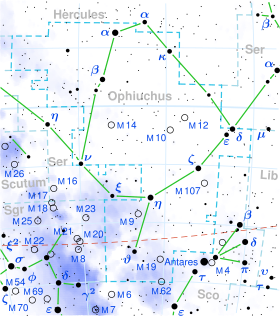41 Ophiuchi
| Observation data Epoch J2000 Equinox J2000 | |
|---|---|
| Constellation | Ophiuchus |
| Right ascension | 17h 16m 36.68653s[1] |
| Declination | −00° 26′ 43.0915″[1] |
| Apparent magnitude (V) | 4.72[2] (4.92 + 7.51)[3] |
| Characteristics | |
| Evolutionary stage | horizontal branch[4] |
| Spectral type | K2III[5] |
| U−B color index | +1.11[6] |
| B−V color index | +1.15[6] |
| Astrometry | |
| Radial velocity (Rv) | −0.16[7] km/s |
| Proper motion (μ) | RA: −31.645[1] mas/yr Dec.: −57.144[1] mas/yr |
| Parallax (π) | 16.1517 ± 0.2358[1] mas |
| Distance | 202 ± 3 ly (61.9 ± 0.9 pc) |
| Absolute magnitude (MV) | 0.72[2] |
| Orbit[8] | |
| Period (P) | 140.76±0.23 yr |
| Semi-major axis (a) | 0.959±0.008″ |
| Eccentricity (e) | 0.866±0.003 |
| Inclination (i) | 65.1±0.0° |
| Longitude of the node (Ω) | 220.5±0.0° |
| Periastron epoch (T) | 1890.53±0.36 B |
| Argument of periastron (ω) (secondary) | 287.5±0.0° |
| Details | |
| 41 Oph A | |
| Mass | 1.46[9] M☉ |
| Radius | 11.80+0.27 −0.39[1] R☉ |
| Luminosity | 60.3±1.0[1] L☉ |
| Surface gravity (log g) | 2.42[10] cgs |
| Temperature | 4,509±65[9] K |
| Metallicity [Fe/H] | +0.06[2] dex |
| Rotational velocity (v sin i) | 2.6[7] km/s |
| Age | 3.73[9] Gyr |
| Other designations | |
| Database references | |
| SIMBAD | data |
41 Ophiuchi is a binary star[8] system in the zodiac constellation of Ophiuchus, and is positioned less than half a degree to the south of the celestial equator. It is visible to the naked eye as a faint, orange-hued point of light with a combined apparent visual magnitude of 4.72.[2] The distance to this system is approximately 202 light years based on parallax.[12]
This is a visual binary with an orbital period of 141 years and an eccentricity of 0.866.[8] The magnitude 4.92[3] primary, designated component A, is an aging K-type giant star with a stellar classification of K2III.[5] It is a red clump giant,[4] which indicates it is on the horizontal branch and is generating energy through helium fusion at its core. The star is 3.7[9] billion years old with 1.46[9] times the mass of the Sun and has expanded to nearly 12[1] times the Sun's radius. It is radiating 60[1] times the Sun's luminosity from its swollen photosphere at an effective temperature of 4,509 K.[9]
The secondary companion, component B, has a visual magnitude of 7.51 and an angular separation of 0.70″ from the primary along a position angle of 22°, as of 2017.[3]
References[]
- ^ a b c d e f g h i Brown, A. G. A.; et al. (Gaia collaboration) (August 2018). "Gaia Data Release 2: Summary of the contents and survey properties". Astronomy & Astrophysics. 616. A1. arXiv:1804.09365. Bibcode:2018A&A...616A...1G. doi:10.1051/0004-6361/201833051. Gaia DR2 record for this source at VizieR.
- ^ a b c d Anderson, E.; Francis, Ch. (2012). "XHIP: An extended hipparcos compilation". Astronomy Letters. 38 (5): 331. arXiv:1108.4971. Bibcode:2012AstL...38..331A. doi:10.1134/S1063773712050015. S2CID 119257644. Vizier catalog entry
- ^ a b c Mason, Brian D.; Wycoff, Gary L.; Hartkopf, William I.; Douglass, Geoffrey G.; Worley, Charles E. (2001). "The 2001 US Naval Observatory Double Star CD-ROM. I. The Washington Double Star Catalog". The Astronomical Journal. 122 (6): 3466. Bibcode:2001AJ....122.3466M. doi:10.1086/323920. Vizier catalog entry
- ^ a b Alves, David R. (August 2000). "K-Band Calibration of the Red Clump Luminosity". The Astrophysical Journal. 539 (2): 732–741. arXiv:astro-ph/0003329. Bibcode:2000ApJ...539..732A. doi:10.1086/309278. S2CID 16673121.
- ^ a b Hoffleit, D.; Warren, W. H. (1995). "VizieR Online Data Catalog: Bright Star Catalogue, 5th Revised Ed. (Hoffleit+, 1991)". VizieR On-line Data Catalog: V/50. Originally Published in: 1964BS....C......0H. 5050. Bibcode:1995yCat.5050....0H.
- ^ a b Mallama, A. (2014). "Sloan Magnitudes for the Brightest Stars". The Journal of the American Association of Variable Star Observers. 42 (2): 443. Bibcode:2014JAVSO..42..443M.Vizier catalog entry
- ^ a b Massarotti, Alessandro; et al. (2008). "Rotational and Radial Velocities for a Sample of 761 Hipparcos Giants and the Role of Binarity". The Astronomical Journal. 135 (1): 209–231. Bibcode:2008AJ....135..209M. doi:10.1088/0004-6256/135/1/209.
- ^ a b c Tokovinin, Andrei; et al. (August 2015). "Speckle Interferometry at SOAR in 2014". The Astronomical Journal. 150 (2): 17. arXiv:1506.05718. Bibcode:2015AJ....150...50T. doi:10.1088/0004-6256/150/2/50. S2CID 30737411. 50.
- ^ a b c d e f Luck, R. Earle (2015), "Abundances in the Local Region. I. G and K Giants", Astronomical Journal, 150 (3), 88, arXiv:1507.01466, Bibcode:2015AJ....150...88L, doi:10.1088/0004-6256/150/3/88, S2CID 118505114.
- ^ Allende Prieto, C.; Lambert, D. L. (1999). "Fundamental parameters of nearby stars from the comparison with evolutionary calculations: Masses, radii and effective temperatures". Astronomy and Astrophysics. 352: 555–562. arXiv:astro-ph/9911002. Bibcode:1999A&A...352..555A. Vizier catalog entry
- ^ "41 Oph". SIMBAD. Centre de données astronomiques de Strasbourg. Retrieved 2019-06-21.
- ^ Van Leeuwen, F. (2007). "Validation of the new Hipparcos reduction". Astronomy and Astrophysics. 474 (2): 653–664. arXiv:0708.1752. Bibcode:2007A&A...474..653V. doi:10.1051/0004-6361:20078357. S2CID 18759600. Vizier catalog entry
- K-type giants
- Horizontal-branch stars
- Binary stars
- Ophiuchus (constellation)
- Durchmusterung objects
- Flamsteed objects
- Henry Draper Catalogue objects
- Hipparcos objects
- HR objects
